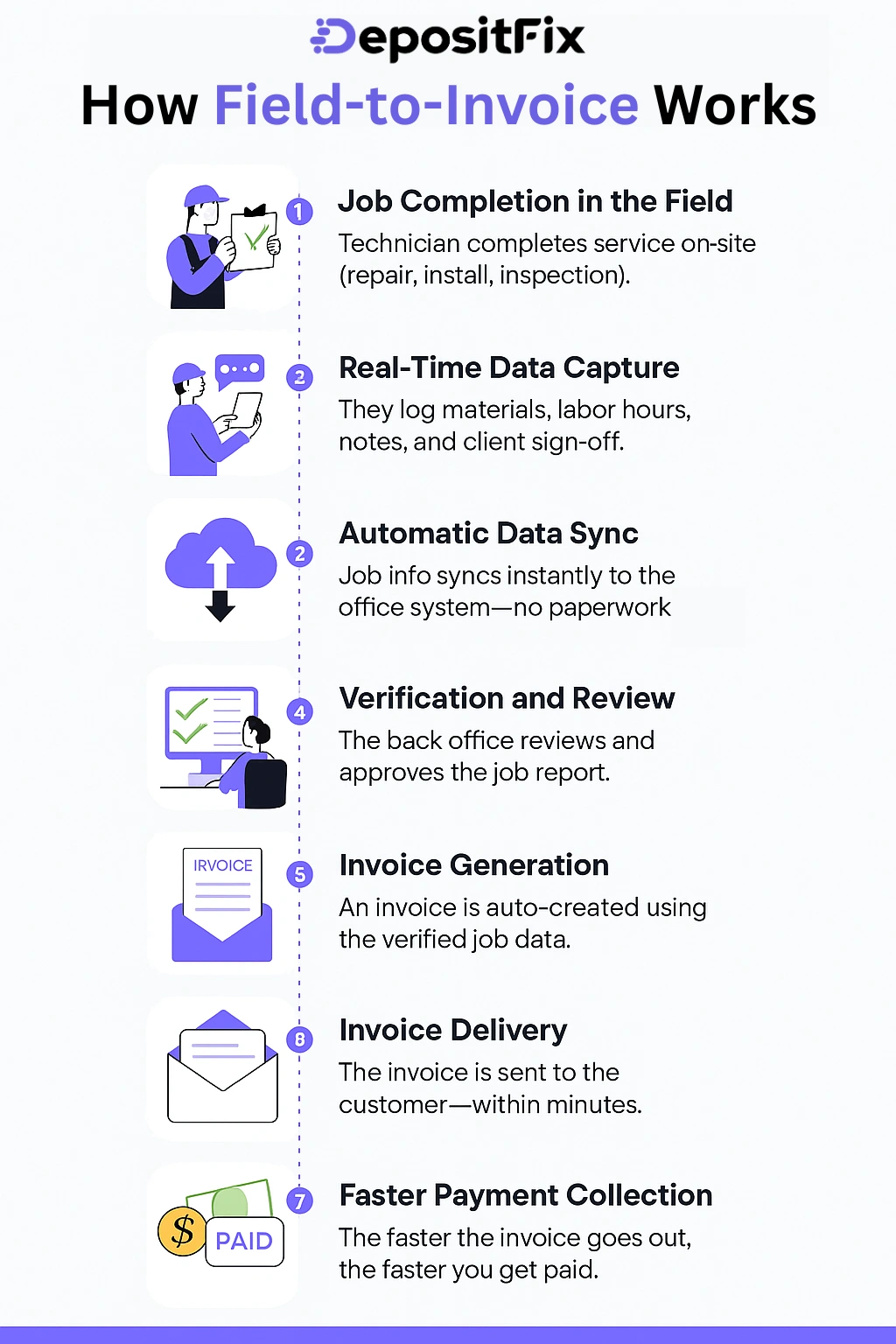Field to Invoice is the process of capturing work done in the field, such as services, labor, or material usage, and turning it into an accurate, timely invoice. A field to Invoice solution is used for businesses in construction, utilities, and field services, as it helps reduce billing delays, improve field service cashflow, and ensure nothing gets missed in the billing cycle.
What Is Field to Invoice
Field to Invoice is a business process that connects field operations directly to billing, ensuring that work performed in the field is accurately documented and quickly turned into an invoice. It is commonly used in industries like construction, utilities, and field services, where technicians or crews perform jobs on-site.
The process begins with job assignment and scheduling, followed by the completion of work and real-time data capture—such as materials used, time spent, and job completion confirmation—through mobile devices or field service software. Once the job is verified, the information flows seamlessly into the back-office system, enabling immediate invoice generation and automated billing of field services.
This streamlined approach reduces administrative delays, minimizes billing errors, shortens the payment cycle, and improves cash flow. When businesses integrate operations, data collection, and field service invoicing into a unified workflow, they can boost efficiency, accountability, and customer satisfaction.
How Does Field to Invoice Work
The Field to Invoice process is a streamlined workflow that connects on-site job completion directly to invoicing, helping businesses reduce delays and improve cash flow, supporting fast, consistent field service invoicing and payments.
This is how it works:
- Job Completion in the Field: A technician or field worker completes a service task on-site—this could be an installation, repair, inspection, or maintenance job.
- Real-Time Data Capture: Using a mobile device or field service app, they log critical information such as labor hours, parts and materials used, photos or videos of the work, customer notes or signatures, etc.
- Automatic Data Sync: The recorded data is instantly transmitted to the back-office system or ERP platform—no waiting, no paperwork.
- Verification and Review: Back-office staff or automated systems validate the information to ensure everything is accurate and complete.
- Invoice Generation: Once approved, the system auto-generates a customer invoice using the submitted job data.
- Invoice Delivery: The invoice is sent to the customer—often within minutes—via email or through a client portal or field invoice software.
- Faster Payment Collection: With no delays between job completion and billing, businesses speed up payment cycles and improve field service cash flow.

Technologies Enabling Field to Invoice
Modern Field to Invoice processes rely on a range of digital tools that connect field operations with back-office billing systems. These technologies ensure fast, accurate, and automated invoicing right after a job is completed.
- Field Service Management (FSM) Software: Centralizes job scheduling, dispatching, and real-time updates from the field.
- Field service payment solution: To complete the Field to Invoice process, integrating a reliable field service payment solution allows technicians to collect payments quickly and securely, speeding up cash flow.
- Mobile Field Apps: Allow technicians to log job details, capture photos, collect digital signatures, and submit reports instantly—whether online or offline.
- Cloud-Based ERP Systems: Integrate with FSM tools to receive job data, validate it, and generate invoices in real time.
- Automation & Workflow Engines: Trigger invoice creation, approval routing, and email delivery without manual steps, reducing processing time and errors.
- Digital Forms & E-Signatures: Replace paper-based documentation, making data collection faster and more reliable.
- GPS Tracking: Confirms technician arrival and time spent on-site, supporting accurate billing and accountability.
- Customer Self-Service Portals: Enable clients to view completed work, download invoices, and make payments online.
These technologies work together to eliminate bottlenecks, reduce administrative tasks, and accelerate cash flow for service-based businesses.
How to Implement Field to Invoice
Implementing a successful Field to Invoice process requires careful planning and the right tools. Here’s how to implement it:
- Assess Your Current Workflow: Review your existing field operations and invoicing processes to identify manual gaps, delays, and inefficiencies.
- Choose a Field Service Management (FSM) System: Select a platform that allows technicians to capture job data, photos, materials used, and digital signatures in real time.
- Integrate FSM with Your Field Service Payment Solution: Ensure that job data collected in the field flows directly into your billing system to trigger automatic invoicing.
- Standardize Digital Job Reporting: Create consistent digital forms and templates for job completion reports to avoid discrepancies and improve accuracy.
- Equip Field Teams with Mobile Devices: Provide smartphones or tablets and train your staff to use the mobile FSM app for capturing and submitting data on-site.
- Set Up Automation Rules: Configure automated workflows to handle job approval, invoice generation, and email delivery without manual intervention.
- Test the Full Workflow: Run test jobs to validate the process end-to-end—from job completion to invoice delivery—and identify areas for improvement.
- Monitor and Optimize: Continuously track performance, gather user feedback, and make process refinements to ensure efficiency and accuracy over time.
A progress invoice lets businesses bill in stages for work completed on long-term projects, improving cash flow and tracking milestone progress.
Progress billing is a payment method that lets you invoice clients as work progresses on long-term projects, helping manage costs and maintain clarity.
Ready to streamline your payment operations?
Discover the hidden automation in your payment, billing and invoicing workflows. Talk to our experts for a free assement!

